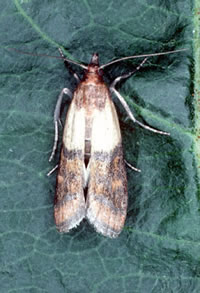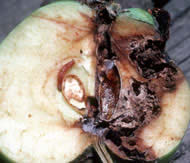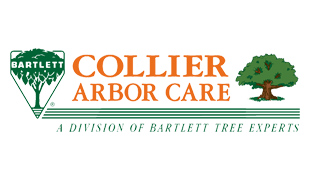|

Adult Codling Moth Codling MothDownload a PDF of this articleDescriptionThe adults are a gray colored moth, but are rarely seen. The larvae are pinkish-white with a brown head. Plants AffectedApple, pear, crabapple and hawthorn. Symptoms/DamageFruitThis pest is one of the most damaging insects of apple and pear. Larval
feeding causes fruit damage. The larvae bore a tunnel to the core of the
fruit and feed on seeds. A brown sawdust-like material extrudes from the
entry hole. Codling moth damage can be confused with apple maggot damage. The difference is codling moth feeds in the core and the apple maggot tunnels throughout the flesh. BarkLarvae pupating in cocoons may be visible in bark crevices, particularly during the winter months. Life CycleThe codling moth spends the winter as a mature larva in a cocoon. Larvae are found under loose bark on the tree, litter at the base of the tree, or in woodpiles. Overwintering larvae begin changing into pupae when the apple blossoms first display pink color. The first adult moths begin to emerge in late spring, when the fruit begins to form, and lay eggs within a day. First generation eggs are laid primarily on leaves, though some are found on fruit. Newly hatched larvae find fruit and enter either at the blossom end or through the side. They bore through the skin and feed on the fruit flesh for a few days, then move towards the core where they feed on seeds. In three to four weeks, when the larvae are fully grown, they leave the fruit in search of sheltered places to spin cocoons. Second generation adults typically begin emerging in mid summer, and in exceptionally warm years a third generation may occur. ManagementCulturalRake up and dispose of apples on the ground. Remove and destroy all litter from under the tree. BiologicalNaturally present and released parasitic wasps can decrease the number of eggs being hatched. Pheromone traps placed in the spring can help reduce populations. The males are attracted to the traps and are caught in the sticky interior. ChemicalAn approved insecticide can be used to control codling moth by 3-4 foliar treatments starting in late spring to mid-summer. A new technology has been developed using a combination of pheromone and an insecticide in a paste which is placed inside traps or applied as small drops on the tree branches. This methodology has proven to be very effective and environmentally friendly. |

Codling Moth damage in apple |
|
Home |
Services |
The Arbor Advisor |
Garden Calendar |
About Us |
Fact Sheets |
Contact Us |
Site Map Collier Arbor Care Portland 503-722-7267 Vancouver (360) 693-6056 Site contents and design ©2013 Collier Arbor Care |





